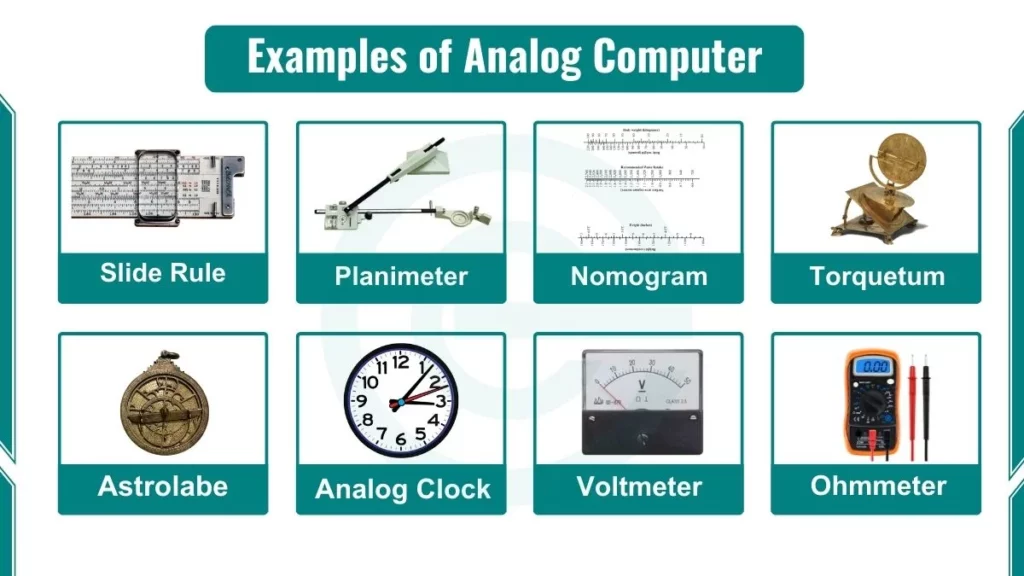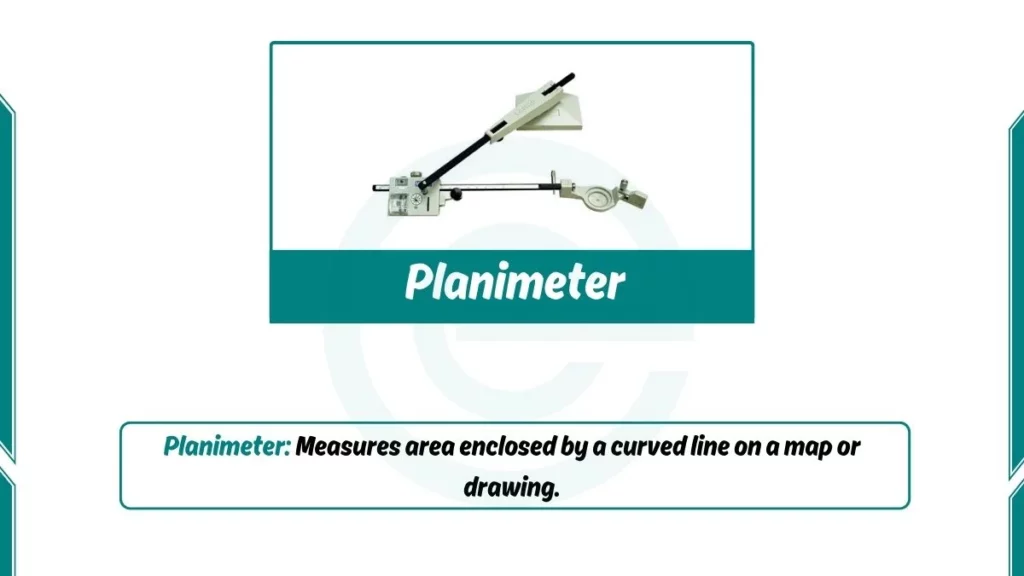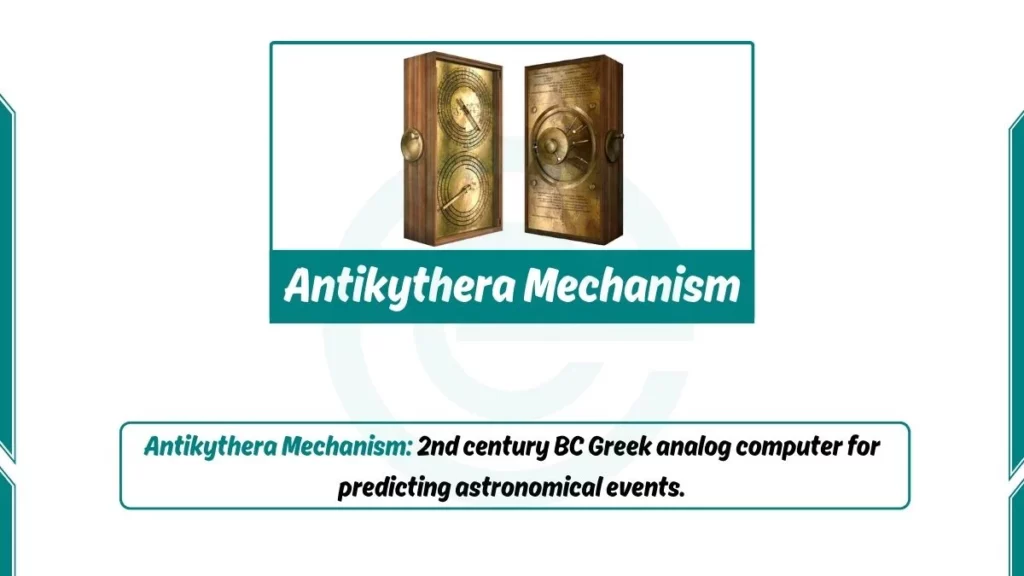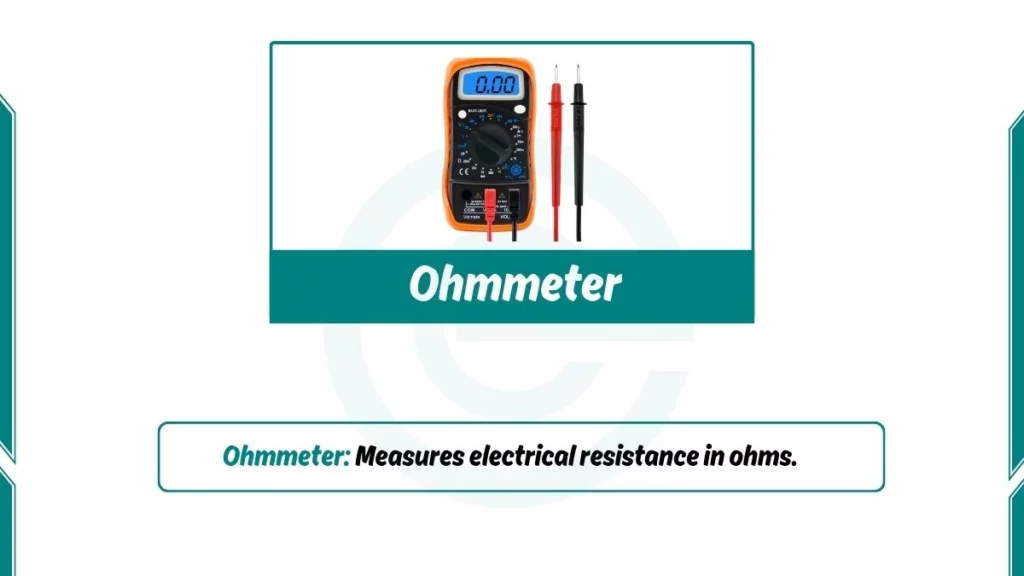Analog computer examples are Slide Rule, Ammeter, Voltmeter, Astrolabe, Torquetum, Nomogram, Planimeter, and more.
An analog computer is a type of computer that operates on continuous physical variables, such as voltage, fluid flow, or mechanical motion, by manipulating these variables to solve problems. If you don’t know how analog computers work, you can also read working principle of an analog computer.
Examples of Analog Computer
Here are some analog computer example with facts:

1. Slide Rule
The slide rule is a mechanical analog computer. It allows users to perform mathematical calculations like multiplication, division, roots, and logarithms by sliding bars across one another. The distance between markers represents numbers, and results are read off using relative distances.
The slide rule operates continuously and measures changes in continuous physical quantities like length to represent numbers. This analog and continuous representation makes the slide rule an analog computer.

Fact: Slide rules were used largely before the 1970s but have since been replaced by digital computing devices.
2. Planimeter
A planimeter is a mechanical device used to measure the area of irregular shapes. It works by tracing the shape to be measured with a wheel that turns an integrating mechanism.
The area calculation depends on the angle and distance traveled by the tracing stylus, which are continuous physical quantities. By integrating a continuous input to generate the output, the planimeter qualifies as an analog computer.

Fact: Planimeters were patented in 1854 and were commonly used for area computations until electronic devices became available.
3. Nomogram
A nomogram is a graphical device built to allow the approximate graphical computation of mathematical functions. It represents variables as distances that can be measured using a straightedge.
The alignment of continuously scaled marks represents the mathematical relationship and gives the solution. Using physical lengths to encode continuous variables, nomograms function as analog computers.

Fact: The term “nomogram” was coined in 1881 and derives from the Greek words “nomos” for law and “gramma” for drawing.
4. Antikythera Mechanism
The Antikythera mechanism is an ancient Greek astronomical calculator device for predicting astronomical positions and eclipses. It uses over 30 precision gear wheels in a differential gear train to represent and model the irregular motions of astronomical bodies. By mechanically modeling continuous celestial motions, it acts as an analog computer focused on astronomical calculations.

Fact: The Antikythera mechanism is dated from around 150-100 BCE, over a thousand years before the appearance of comparable astronomical clocks in medieval Europe.
5. Torquetum
The torque-tum is a medieval astronomical instrument used to determine the position of celestial bodies in the sky. It consists of circular scales and pointers that rotate around a common axis. It allows the angles between astronomical bodies to be read out directly.
The pointers rotate by the continuous movement of stars and planets. This analog mechanism for astronomic modeling allows the torquetum as an analog computer.

Fact: The oldest surviving torquetum dates from 1392 and is attributed to famed instrument maker Jacques de St. Omer.
6. Astrolabe
The astrolabe is an ancient astronomical instrument that was used to identify stars and planets and to determine local time based on astronomical measurements. It consists of nested circular plates representing the skies, with pointers and scales that rotate over each other to model the motions of celestial bodies.
By using mechanical analog modeling of continuous astronomical motions, the astrolabe functions as an analog computer focused on astronomic applications.

Fact: Astrolabe dates back over 2,000 years to classical Greece. Medieval astrolabes often functioned as elaborate works of art in addition to their functional purposes.
7. Analog Clock
The analog clock uses rotating hands sweeping over a continuous circular scale to represent the continuous passage of time. The angle traveled by the hands is directly proportional to time elapsed.
This analog mechanism to model a continuous physical process makes the analog clock a simple specialized analog computer focused on keeping time.

Fact: Analog clocks are now often designed for aesthetic appeal, they evolved from precision astronomical and navigational instruments.
8. Gyroscope
A gyroscope uses a spinning rotor to detect and measure the orientation in 3D space. The rotor spins continuously at a constant rate, resisting changes to its orientation. This analog leverage of angular momentum along continuous rotational axes makes the gyroscope an analog computing device specialized for stability and orientation applications.
Fact: Gyroscopes are now found in most smartphones and tablets to detect tilt and rotation for games, cameras, and navigation.
9. Voltmeter
A voltmeter is an analog electrical device used to measure voltage in an electric circuit. It works by mechanically deflecting an indicating needle proportionally to the voltage being measured, which is a continuous variable. This analog encoding of a continuous electrical signal makes the voltmeter function as a simple specialized analog computer.

Fact: The first working voltmeters were created in the 18th century by Alessandro Volta himself, after whom the volt unit is named.
10. Ammeter
The ammeter is an analog device used to measure electric current in amperes within a circuit. Similar to a voltmeter. It uses the magnetic fields generated by current through a coil to mechanically deflect a pointer.
The deflection angle represents the magnitude of the continuous current flowing. This constitutes analog computing focused on current measurement.
Fact: Early ammeters worked by passing all circuit current through a wire coil a dangerous approach that led to instrument failures.
11. Ohmmeter
An ohmmeter measures electrical resistance between two points in a circuit. Modern digital ohmmeters calculate resistance indirectly from a current measurement but traditional analog ohmmeters use a delicate voltage or current source feeding into a meter movement.
The movement reading depends continuously on the resistance in the circuit. By leveraging continuous analog signals, the analog ohmmeter acts as an analog computer for resistance measurement.

Fact: The first ohmmeters constructed by Georg Ohm himself used analog means like a galvanometer needle to read resistance.
12. Hygrometer
A hygrometer is a device used to measure relative ambient humidity in the atmosphere. Some hygrometers work by using humidity-sensitive materials like hair or paper that mechanically change length or twist proportionally to the moisture content.
This analog mechanism to translate a continuous environmental quantity makes hygrometers analog computers optimized for humidity measurement.
Fact: The first crude hygrometers were simply pieces of straw that were observed to bend and change shape with humidity.
13. Barometer
A barometer measures ambient atmospheric pressure using an analog pressure sensor like an array of hollow metal tubes. The continuous displacement of these tubes encodes the small pressure changes in the surrounding air. Barometers translate these analog displacements into pressure readings.
Fact: Before digital pressure sensors, barometers used rising liquid levels and floating indicators to register minor pressure changes.
14. Altimeter
An altimeter device measures altitude or elevation by calculating air pressure differences. Traditional analog altimeters contain an aneroid barometer capsule that expands/contracts with pressure changes during ascent/descent.
These continuous motions are amplified mechanically to drive an altitude pointer. By sensing continuous pressure shifts, the analog altimeter acts as an analog computer optimized for aircraft.
Fact: Early altitude measurements involved simply boiling water to determine its boiling point which changes predictably with elevation.
15. Thermometer
A thermometer computes temperature by translating heat energy into expansion/contraction of a temperature-sensitive liquid like mercury or alcohol contained in a sealed glass tube.
The liquid level rising proportionally to temperature makes a thermometer an analog computer calibrated to compute heat. Modern digital thermometers compute temperature from electrical resistance changes rather than liquid expansion.
Fact: Crude ancient thermometers worked simply by noticing material displacements, like air pushing against a thin tube immersed in a heated liquid.
16. Psychrometer
A psychrometer measures relative humidity by comparing the temperatures of two thermometers with a water-moistened wick. As liquid water evaporates, it cools the “wet bulb” thermometer proportionally to the drying power of the air.
The psychrometer computes humidity from the continuous temperature difference, making it an analog device specialized for humidity measurement.
Fact: Psychrometers convert evaporation cooling into readable humidity data but evaporation also cools many biological organisms for temperature regulation.
17. pH Meter
A pH meter measures the acidity or alkalinity of a solution by immersing an electrode paired with a voltage meter. The small pH-dependent voltage from the electrode is an analog signal used to drive the meter display.
By converting a continuous chemical process into an electrical signal the pH meter functions as an analog chemical analysis computer.
Fact: An American biochemist named Arnold Beckman created one of the first electronic pH meters in 1934.
18. FN Tube Integrator
The FN tube integrator was an early electronic analog computer built to solve differential equations. It used large capacitor tubes able to “integrate” current over time by accumulating surface charge from flowing electrons.
The charge stored in the tube operated like an analog memory representing the time integral. This made the FN tube integrator specialized for analog integration and therefore worked as an analog computer.
Fact: MIT professor Vannevar Bush was one of the early pioneers in developing the FN tube integrator and applying it to science and engineering problems requiring calculus.
19. Bush Differential Analyzer
The Bush Differential Analyzer was a landmark analog computer built by Vannevar Bush at MIT to solve differential equations with up to six degrees of freedom. It used mechanically driven wheel-and-disc integrators, torque amplifiers, and output tables to compute continuous solutions to complex dynamic systems.
This pioneering general-purpose analog computing machine could model wonders like transient oscillations in power systems or control systems.
Fact: A Differential Analyzer was installed at the headquarters of the United States Census Bureau in 1947 to assist with population forecasting and analysis.
20. Water Tank Integrator
A water tank integrator is a hydro-mechanical device that uses changing water levels in interconnected tanks to solve calculus problems. Input flow rates represent the mathematical function, while water levels correspond to the integral.
Measuring the water levels outputs the integral of the input function. By using gravitational potential energy analogously, the water tank integrator acts as an analog computer.
Fact: One of the largest water tank integrator analog computers was built at UCLA in 1947.
